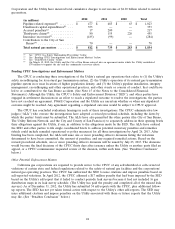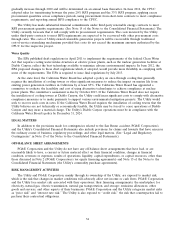PG&E 2012 Annual Report Download - page 29
Download and view the complete annual report
Please find page 29 of the 2012 PG&E annual report below. You can navigate through the pages in the report by either clicking on the pages listed below, or by using the keyword search tool below to find specific information within the annual report.In addition, in July 2012, the Utility reported to the CPUC that it had discovered that its access to some
pipelines has been limited by vegetation overgrowth or building structures that encroach upon some of the Utility’s
gas transmission pipeline rights-of-way. The Utility is undertaking a system-wide effort to identify and remove
encroachments from its pipeline rights-of-way over a multi-year period. (See ‘‘Operating and Maintenance’’ above.)
PG&E Corporation and the Utility are uncertain how this matter will affect the above investigative proceedings
related to natural gas operations, or whether additional proceedings or investigations will be commenced that could
result in regulatory orders or the imposition of penalties on the Utility.
Penalties Conclusion
The CPUC can impose penalties of up to $20,000 per day, per violation. (For violations that are considered to
have occurred on or after January 1, 2012, the statutory penalty has increased to a maximum of $50,000 per day, per
violation.) The CPUC has wide discretion to determine the amount of penalties based on the totality of the
circumstances, including such factors as the gravity of the violations; the type of harm caused by the violations and
the number of persons affected; and the good faith of the entity charged in attempting to achieve compliance, after
notification of a violation. The CPUC is also required to consider the appropriateness of the amount of the penalty
to the size of the entity charged. The CPUC has historically exercised this wide discretion in determining penalties.
The CPUC’s delegation of enforcement authority to the SED allows the SED to use these factors in exercising
discretion to determine the number of violations, but the SED is required to impose the maximum statutory penalty
for each separate violation that the SED finds.
The CPUC has stated that it is prepared to impose significant penalties on the Utility if the CPUC determines
that the Utility violated applicable laws, rules, and orders. In determining the amount of penalties the ALJs may
consider the testimony of financial consultants engaged by the SED and the Utility. The SED’s financial consultant
prepared a report concluding that PG&E Corporation could raise approximately $2.25 billion through equity
issuances, in addition to equity PG&E Corporation had already forecasted it would issue in 2012, to fund CPUC-
imposed penalties on the Utility. The Utility’s financial consultant disagreed with this financial analysis and asserted
that a fine in excess of financial analysts’ expectations, which the consultant’s report cited as a mean of $477 million,
would make financing more difficult and expensive. The ALJs have scheduled a hearing to be held on March 4 and
March 5, 2013 to consider the SED’s and Utility’s testimony. The SED and other parties are scheduled to file briefs
to address potential monetary penalties and remedies in all three investigations by April 26, 2013.
PG&E Corporation and the Utility believe it is probable that the Utility will incur penalties of at least
$200 million in connection with these pending investigations and potential enforcement matters and have accrued
this amount in their consolidated financial statements. PG&E Corporation and the Utility are unable to make a
better estimate of probable losses or estimate the range of reasonably possible losses in excess of the amount accrued
due to the many variables that could affect the final outcome of these matters and the ultimate amount of penalties
imposed on the Utility could be materially higher than the amount accrued. These variables include how the CPUC
and the SED will exercise their discretion in calculating the amount of penalties, including how the total number of
violations will be counted; how the duration of the violations will be determined; whether the amount of penalties in
each investigation will be determined separately or in the aggregate; how the financial resources testimony submitted
by the SED and the Utility will be considered; whether the Utility’s costs to perform any required remedial actions
will be considered; and whether and how the financial impact of non-recoverable costs the Utility has already
incurred, and will continue to incur, to improve the safety and reliability of its pipeline system, will be considered.
(See ‘‘CPUC Gas Safety Rulemaking Proceeding’’ below.)
These estimates, and the assumptions on which they are based, are subject to change based on many factors,
including rulings, orders, or decisions that may be issued by the ALJs; whether the outcome of the investigations is
resolved through a fully litigated process or a stipulated outcome that is approved by the CPUC; whether the SED
will take additional action with respect to the Utility’s self-reports; and whether the CPUC or the SED takes any
action with respect to the encroachment matter described above. Future changes in these estimates or the
assumptions on which they are based could have a material impact on PG&E Corporation’s and the Utility’s
financial condition, results of operations, and cash flows.
CPUC Gas Safety Rulemaking Proceeding
The CPUC is conducting a rulemaking proceeding to develop and adopt new safety and reliability regulations
for natural gas transmission and distribution pipelines in California and the related ratemaking mechanisms. On
December 28, 2012, the CPUC issued a decision that approved most of the Utility’s proposed pipeline safety
25
























